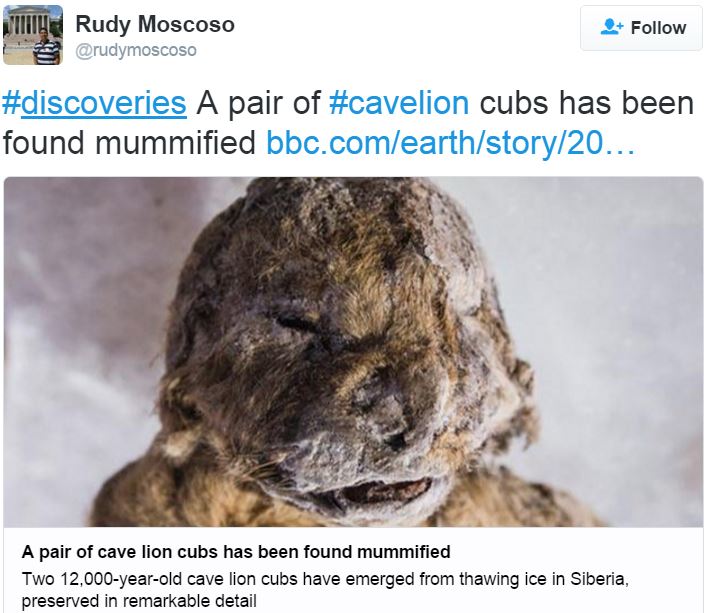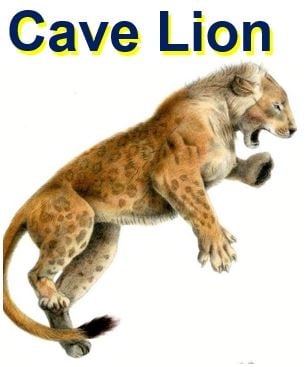Cloning Siberian Lions, also known as Cave Lions, which roamed during the Ice Age, is possible, says South Korean scientist Prof. Hwang Woo-suk, a cloning expert who plans to use DNA from two well-preserved 12,000-year-old cubs which were discovered on the bank of the Uyandina River in the Abyisky district, Siberia.
The two cubs, called Dina and Uyan, are the best-preserved specimens of this long-gone species. They were dug from the permafrost last year, and made their first appearance since Pleistocene times (Pleistocene = 2,588,000 to 11,700 years ago).
The frozen cubs were located by a group of researchers who had been searching the area for mammoth tusks.
 When the cubs were discovered last year, the news spread across the world rapidly. Journalist Rudy Moscoso posted the above message and image on Twitter. (Image: Twitter)
When the cubs were discovered last year, the news spread across the world rapidly. Journalist Rudy Moscoso posted the above message and image on Twitter. (Image: Twitter)
The Siberian Times quoted Dr. Albert Protopopov, head of the mammoth fauna studies department of the Yakutian Academy of Sciences, who said that the specimens were:
“Complete with all their body parts: fur, ears, soft tissue and even whiskers.”
Prof. Woo-suk, who is currently working on bringing the extinct woolly mammoth back with a clone, is in Siberia. He says he is obtaining samples of one of the Siberian lion cubs and believes he can produce a clone.
Prof. Hwang Woo-suk became infamous in 2006 for fabricating a series of experiments which had appeared in high-profile journals. He was dismissed by Seoul National University. Until the scandal, he was known as the ‘Pride of Korea’ in South Korea.
 One of the preserved Cave Lion cubs, and Prof. Woo-suk looking at a sample. He went to Siberia to get them. He hopes to create a clone. (Image: Twitter)
One of the preserved Cave Lion cubs, and Prof. Woo-suk looking at a sample. He went to Siberia to get them. He hopes to create a clone. (Image: Twitter)
Dr. Protopopov said his team, along with experts from the Mammoth Museum, took samples for cell research. Scientists working at the Museum are currently studying the samples to see whether any of their cells might be suitable for cloning.
Apparently, there was a dispute between Prof. Woo-suk and the Siberian scientists regarding the size of the sample. He wanted to take a part of the skull or leg – a large section – but local experts were against his proposal, saying he should be given a smaller sample.
One specimen will remain untouched
Local scientists are holding onto one of the cubs – the better-preserved one – called Uyan. They think that more advanced techniques in the future will probably be more successful in creating a clone, compared to what scientists are capable of today. So, Uyan will not be released to any scientist.
Dr. Protopopov said, regarding Uyan:
“We intend to keep it for the future. The methods of research are constantly being improved, about once a decade there is a mini-revolution in this area. So we will do everything possible to keep this carcass frozen for as long as possible.”
“The dispute arose from the fact that the researchers, as always, want to be completely sure and take more tissue, and I can understand them. But the lion is not fully preserved and there are not so many tissues. We have planned other studies, so it is important to preserve the original morphology of the remains. Such disputes are normal in all studies, and in the end we came to a compromise.”
 The Cave Lion, also called the European or Eurasian Cave Lion, preyed on large herbivores, including bison, reindeer, deer, horses and young or injured mammoths. Whether they hunted cave bears is debatable – some people say the bear would win in a fight (see video below). (Image: Wikipedia)
The Cave Lion, also called the European or Eurasian Cave Lion, preyed on large herbivores, including bison, reindeer, deer, horses and young or injured mammoths. Whether they hunted cave bears is debatable – some people say the bear would win in a fight (see video below). (Image: Wikipedia)
Semyon Grigoriev, Director of the Mammoth Museum, said the South Koreans were unhappy and skeptical with the samples they were given.
Dr. Grigoriev said:
“The Koreans are sceptical and unhappy with the samples,’ he said. ‘They expected to take more, as they did with the mammoth previously. But it will not work with with these little kittens.”
“You have to understand, the lion cub is very small, so it was not possible to take as much as we would like. In addition, the material is highly degraded, it is partially mummified, but the part that was in the ice, preserved very well. We managed to take some samples of skin along with the muscle tissue, and we hope that we will find what we want in these samples.”
Specialists will be carrying out an autopsy on the specimen later this year.
Cubs were very young
Dr. Protopopov, who compared the two frozen specimens with modern lion cubs, believes that they were perhaps one or two weeks old when they died and froze. Their eyes had not fully opened “they have baby teeth and not all had appeared,” he said.
Siberian scientists believe the cubs may have died after their mother hid them in a cave to protect them from hungry male lions. Then a landslide blocked off the entrance, which sealed their fate, but also helped preserve them so well.
This summer, a research team will go back to the same site to see whether they can find other cubs, or perhaps even a lioness.
Cave lions Panthera spelaea existed during the Middle and Late Pleistocene era – up to about 11,700 years ago. They occupied most of northern Asia and Europe, spanning from the United Kingdom to Chukitka in the far east of Russia. They probably also roamed northwestern Canada and Alaska.
Scientists are hoping these two cubs might help explain why their species became extinct. They had few predators, were smaller than herbivores, and were not the type of animal to get stuck in swamps, like rhinos and woolly mammoths. Perhaps their main food source became scarce.
Video – Cave Lion versus Cave Bear
This BBC video explains that the Cave Lion’s prey, such as reindeer, started to become scarce. There is also an animated scene of a fight with a Cave Bear, which the lion loses.

